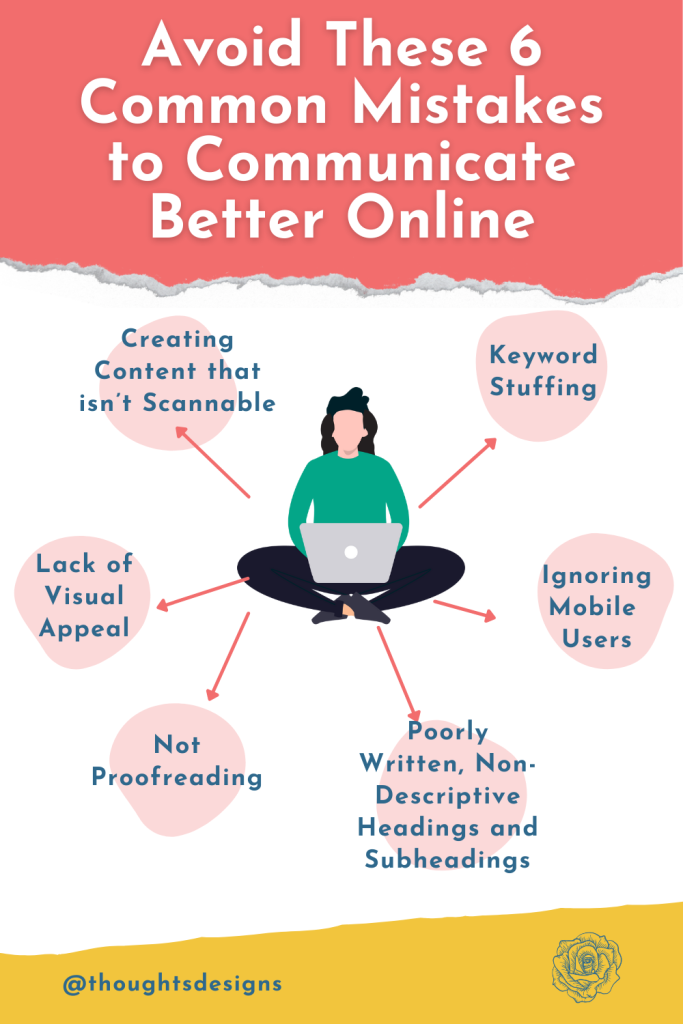Learning to communicate better online is an enormous part of growing your business online. When creating content for your website and communicating online, there are six big mistakes I notice many website owners struggle with. Let’s talk about them one by one, and how to overcome these common errors.
Communicate Better in Writing: Copywriting for Entrepreneurs
I know what you’re probably thinking. “I thought I was done with school!”
Sorry.
Deciding what to say on your website is an immense challenge for many website owners. After all, you didn’t start a business to become an expert copywriter, right?
You have two options:
- DIY your copywriting
- Hire someone who is skilled at copywriting.
I strongly recommend going with the latter. Look for someone whose writing experience is in your niche and involves online web and marketing copy for the best results.
If you choose to do it yourself, that’s also doable, once you get past the learning curve of writing for the web and learning to communicate better in your marketing copy.
Writing isn’t your only challenge regarding online communication and content. How you format content on your website can have an enormous impact on your online success.
Mistake # 1: Creating Content that isn’t Scannable
Your customers don’t read on the web like they read a book or a newspaper. They don’t read each word. They scan down the page.
Many studies have shown website visitors will leave a website if greeted with a wall of text. The average website visitor decides in 5-10 seconds whether to stay on a website. This means you need to get your point across in under 5 seconds, or you’ve lost them.
Translation: don’t give someone your life story and how your great granddad dreamed up this company. They don’t care about that. They care about finding out if you are the person who might help them solve their problem, and they need to figure that out within the first five seconds of hitting your website.
The Solution: When formatting your web content, use headings, subheadings, bullet points, and brief paragraphs to make it easier for your visitors to scan your page.
Mistake #2: Keyword Stuffing
Once someone learns a little about SEO and keywords, sometimes they write content filled to overflowing with keywords, making the content sound unnatural. Keyword stuffing does not help your SEO and it can give your readers a poor user experience. This, in turn, hurts your search engine rankings even more.
The Solution: Use keywords wisely. Keywords are words and phrases a searcher is using to find content like yours. But getting found in the search engines is only part of the picture.
Creating helpful content that gives potential customers what they’re looking for and answers their questions will help you more in the long run, even if it contains fewer keywords used naturally within the content.
Mistake #3: Ignoring Mobile Users
Most people now surf the web from their mobile phones. Many websites are not providing a user friendly experience for those reading on their phones.
Pop ups and ads that cover content are an enormous problem, as anyone who has tried to read on a news site can tell you. Too small font sizes, without enough background contrast, may make reading on a cell phone difficult.
The Solution: This solution starts with a responsive website design overall.
But beyond that, make sure that each page you create looks great on phones, avoiding excessive ads, auto-playing videos and audios, and type in the optimal size and color for maximum readability.
As a web designer, I encourage everyone to visit their own website regularly on their phones, to make sure your visitors are getting a great experience even on small screens..
Mistake #4: Poorly Written, Non-Descriptive Headings and Subheadings

Using headings and subheadings to break up long bits of text helps readers scan down your content. But it’s not enough to add headings and subheadings. If those headings are not clear or relevant to the content beneath them, you’re not providing a great user experience for your visitors.
An easy way to communicate better with your target audience is with well written headings and subheadings throughout your content.
The Solution: Write engaging headings that apply to your content. Your headings and subheadings are not just great tools to make your content user-friendly; they also help your on-page SEO efforts.
Mistake #5: Not Proofreading
Look, we’re not in school anymore. We’re not getting a grade, per se. But, we’re being graded differently. Our potential customers see what we’re putting out there on the web, and decide based on that whether to look into hiring us or shopping with us.
Typos, grammatical errors, and broken links erode your business’ and website’s credibility. When we communicate better, we have more opportunities for our business to grow.
The Solution: There are a few solutions I recommend.
The first is to always have another person read your web content. Make sure this is not your spouse or anyone else who will only say “Great Job, honey!” You want someone who will be helpful and honest. Even better if you have someone who is like your ideal customer base, so you can double check that the content makes sense and is free of obvious errors.
The second is to run it through a proofreading software like ProWritingAid, which doesn’t just catch spelling errors, but also grammar and usability errors. What I love about ProWritingAid is how it also recommends changes, too.
Mistake #6: Lack of Visual Appeal
As I mentioned earlier, being greeted with a wall of text is a huge turnoff for many web visitors. Just opening a web page and seeing text only looks boring and may cause visitors to leave too soon.
Ideally your site design, images, colors, and branding should all work in harmony with your content to communicate better with your target audience.
The Solution: Adding visual elements such as photos and embedded videos can help break up the monotony of text-only pages, and help readers digest information in other ways too. On a WordPress website, this is super easy to do, and it makes a big impact.
As you communicate better, your web content should engage, inform, and inspire the action you want your potential customers to take. By avoiding these pitfalls, you’ll move closer to achieving your website’s goals by providing a better user experience through better formatted content.


